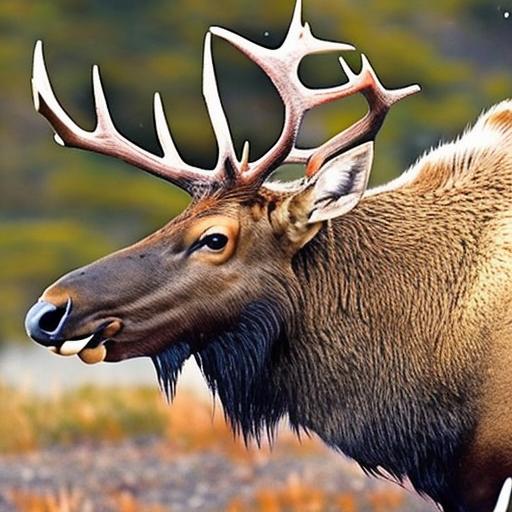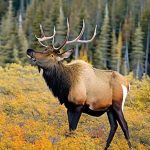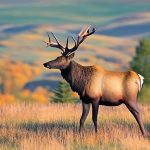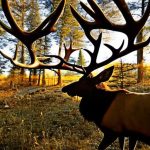Your cart is currently empty!

Unleashing the Thrill of Canada Elk Hunting: A Guide to an Unforgettable Adventure

Elk hunting in Canada is a popular activity among hunters, and for good reason. Canada is home to vast wilderness areas that provide the perfect habitat for elk, making it an ideal destination for those looking to pursue this majestic animal. Whether you are a seasoned hunter or a beginner, elk hunting in Canada offers a unique and thrilling experience.
When embarking on an elk hunting trip in Canada, you can expect to be surrounded by breathtaking landscapes and pristine wilderness. The thrill of the hunt, the challenge of tracking and spotting elk, and the satisfaction of a successful harvest are all part of the experience. Additionally, elk hunting in Canada allows hunters to immerse themselves in nature and disconnect from the hustle and bustle of everyday life.
Key Takeaways
- Elk hunting in Canada offers a unique and challenging experience for hunters.
- The best time and place to hunt elk in Canada is during the fall in the Rocky Mountains.
- Proper preparation for an elk hunting trip includes obtaining permits, bringing appropriate gear, and prioritizing safety.
- Tracking and spotting elk requires patience, knowledge of their habits, and the ability to read signs in the environment.
- Mastering the art of calling elk involves understanding their language and using the right calls at the right time.
The Best Time and Place to Hunt Elk in Canada
The ideal time of year to hunt elk in Canada is during the fall season, specifically September through November. This is when elk are most active and vocal, making it easier to track and locate them. The rutting season, which typically occurs in September, is particularly exciting as it brings out the primal instincts of the elk and increases their activity levels.
When it comes to choosing the best provinces and territories for elk hunting in Canada, there are several options to consider. Alberta, British Columbia, Saskatchewan, and Manitoba are known for their abundant elk populations and offer excellent hunting opportunities. Each province has its own regulations and hunting seasons, so it’s important to research and familiarize yourself with the specific rules and requirements before planning your trip.
Factors to consider when choosing a hunting location include accessibility, terrain, and population density. Some hunters prefer remote areas with rugged terrain, while others may opt for more accessible locations with higher concentrations of elk. It’s also important to consider the availability of accommodations and amenities in the area you choose.
Preparing for Your Elk Hunting Trip: Gear, Permits, and Safety
Before embarking on an elk hunting trip in Canada, it’s essential to ensure you have the right gear and permits. Some of the essential gear for an elk hunting trip includes a high-quality rifle or bow, appropriate ammunition or arrows, camouflage clothing, sturdy boots, binoculars, a backpack, and a field dressing kit. It’s also important to pack enough food, water, and camping supplies if you plan on staying in the wilderness for an extended period.
Obtaining the necessary permits and licenses is crucial to ensure you are hunting legally and ethically. Each province and territory in Canada has its own regulations and requirements for hunting elk, so it’s important to research and understand the specific rules before your trip. This may include obtaining a hunting license, purchasing tags or permits for elk, and adhering to bag limits and hunting seasons.
Safety should always be a top priority when hunting in the wilderness. It’s important to familiarize yourself with the area you will be hunting in, including potential hazards such as steep terrain, bodies of water, or dangerous wildlife. It’s also crucial to let someone know your hunting plans and expected return time, as well as carry essential safety equipment such as a first aid kit, a compass or GPS device, and a means of communication in case of emergencies.
Tracking and Spotting Elk: Tips and Techniques
| Tracking and Spotting Elk: Tips and Techniques |
|---|
| 1. Understanding Elk Behavior |
| 2. Identifying Elk Tracks and Sign |
| 3. Using Optics and Scouting Techniques |
| 4. Stalking and Approaching Elk |
| 5. Calling Elk: Types and Techniques |
| 6. Shooting and Field Dressing Elk |
| 7. Safety and Ethics in Elk Hunting |
Tracking and spotting elk in the wild can be challenging but rewarding. One of the most effective ways to track elk is by looking for signs such as tracks, droppings, rubs on trees, or wallows. Fresh signs indicate recent elk activity and can help you determine their direction of travel.
When it comes to spotting elk from a distance, it’s important to have a good vantage point and use binoculars or spotting scopes. Look for movement or any unusual shapes that may indicate the presence of elk. Pay attention to open areas such as meadows or clearings, as elk often graze in these areas.
Understanding elk behavior is crucial for successful tracking and spotting. Elk are social animals and often travel in herds, so if you spot one elk, there is a good chance there are more nearby. Additionally, elk are most active during the early morning and late afternoon, so these are the best times to focus your efforts.
The Art of Calling Elk: Mastering the Elk Language
Calling elk is an essential skill for any elk hunter. Elk calls mimic the sounds that elk make to communicate with each other, and by using these calls, hunters can attract elk and bring them closer for a better shot. There are different types of elk calls, including bugles, cow calls, and calf calls, each serving a specific purpose.
Bugles are the most common type of elk call and are used to imitate the sound of a bull elk during the rutting season. Cow calls mimic the sounds that female elk make to attract males, while calf calls imitate the sounds made by young elk. Knowing when to use each type of call is crucial for success.
Mastering elk calling techniques takes practice and patience. It’s important to start by listening to recordings of elk calls to familiarize yourself with the sounds. Then, practice making these sounds using a bugle or mouth diaphragm call. It’s important to practice in different tones and volumes to imitate different situations and distances.
The role of elk calls in hunting success cannot be overstated. By using calls effectively, hunters can lure elk within range and increase their chances of a successful harvest. However, it’s important to use calls responsibly and ethically, as overcalling can spook elk or alert other hunters in the area.
Shooting and Field Dressing Elk: Essential Skills for a Successful Hunt

Properly shooting an elk is crucial for a successful hunt. It’s important to practice shooting from different positions and distances to ensure accuracy and confidence in your abilities. When shooting an elk, aim for the vitals, which include the heart and lungs. This will ensure a quick and humane kill.
After successfully harvesting an elk, it’s important to field dress and process the meat properly. Field dressing involves removing the internal organs of the animal to prevent spoilage and contamination. It’s important to have a sharp knife and knowledge of the anatomy of the animal to perform this task effectively.
Processing elk meat involves butchering the animal into manageable cuts and packaging them for storage or transportation. It’s important to keep the meat clean and cool during this process to prevent spoilage. If you are not familiar with butchering, it may be beneficial to take a butchering course or seek the assistance of a professional.
Ethical hunting practices should always be followed when shooting and field dressing elk. This includes ensuring a quick and humane kill, minimizing suffering, and utilizing as much of the animal as possible. It’s important to respect the animal and its environment throughout the entire hunting process.
Cooking and Enjoying Elk Meat: Recipes and Tips
Elk meat is known for its unique flavor and nutritional benefits. It is leaner than beef and has a rich, gamey taste that many people enjoy. There are numerous delicious recipes for cooking elk meat, ranging from simple grilled steaks to elaborate stews or roasts.
When cooking elk meat, it’s important to keep in mind that it is leaner than other meats, which means it can dry out quickly if overcooked. It’s best to cook elk meat to medium-rare or medium doneness to retain its juiciness and tenderness. Marinating the meat before cooking can also help enhance its flavor and moisture.
Some popular recipes for cooking elk meat include elk burgers, elk chili, elk stir-fry, and elk roast. These recipes can be adapted to suit personal preferences and dietary restrictions. It’s important to handle and store elk meat properly to ensure its freshness and safety.
Elk meat is not only delicious but also packed with nutrients. It is high in protein, iron, and B vitamins, making it a healthy choice for those looking to incorporate more lean meats into their diet. By properly cooking and enjoying elk meat, hunters can fully appreciate the fruits of their labor.
Hunting with a Guide vs. Going Solo: Pros and Cons
When planning an elk hunting trip in Canada, hunters have the option of hiring a guide or going solo. Both options have their pros and cons, and the decision ultimately depends on personal preferences, experience level, and budget.
Hunting with a guide can be beneficial for those who are new to elk hunting or unfamiliar with the area they plan to hunt in. Guides have extensive knowledge of the local terrain, elk behavior, and hunting techniques, which can increase the chances of a successful hunt. They can also provide valuable assistance with tracking, spotting, calling, and field dressing.
Another advantage of hunting with a guide is the convenience and peace of mind it provides. Guides often take care of logistics such as transportation, accommodations, meals, and permits, allowing hunters to focus solely on the hunt. Additionally, guides are familiar with the local regulations and can ensure hunters are hunting legally and ethically.
On the other hand, going solo allows hunters to have complete control over their hunting experience. It provides an opportunity for self-reliance and independence in the wilderness. Going solo also allows hunters to fully immerse themselves in nature and disconnect from the distractions of everyday life.
However, going solo requires a higher level of preparation and knowledge. Hunters must be familiar with the area they plan to hunt in, have the necessary skills and equipment, and be able to navigate the wilderness safely. It’s also important to have a backup plan in case of emergencies or unexpected situations.
Conservation and Ethics in Elk Hunting: Respecting the Wildlife and the Environment
Conservation and ethics play a crucial role in elk hunting. Responsible hunting practices are essential to ensure the sustainability of elk populations and the preservation of their habitat. Hunters should always adhere to local regulations, bag limits, and hunting seasons to prevent overharvesting and maintain healthy populations.
Minimizing the impact of hunting on the environment is also important. This includes practicing Leave No Trace principles, such as packing out all trash, minimizing campfire impacts, and respecting wildlife and their habitats. It’s important to be mindful of the potential effects of hunting on other species and ecosystems in the area.
Conservation organizations play a vital role in elk hunting by advocating for sustainable hunting practices, conducting research, and implementing conservation initiatives. Supporting these organizations through donations or volunteer work can help ensure the long-term viability of elk populations and their habitats.
Ethical hunting practices go beyond legal requirements and include treating animals with respect and minimizing suffering. This includes ensuring a quick and humane kill, utilizing as much of the animal as possible, and practicing fair chase principles. It’s important to remember that hunting is a privilege and should be approached with reverence for the wildlife and the environment.
Memories for a Lifetime: Capturing Your Elk Hunting Adventure through Photography and Storytelling
An elk hunting adventure in Canada is an experience worth preserving and sharing. Capturing great photos during your trip allows you to relive the memories and share them with others. It’s important to have a good camera with a telephoto lens to capture wildlife from a distance without disturbing them.
When taking photos during an elk hunting trip, it’s important to be patient and observant. Look for unique moments or interesting compositions that tell a story. Pay attention to lighting conditions and try to capture the beauty of the landscape as well as the animals.
Storytelling is another powerful way to preserve and share your elk hunting adventure. Whether through writing, video, or social media, sharing your experiences and insights can inspire others and create a sense of community among fellow hunters. It’s important to be authentic and honest in your storytelling, focusing on the emotions and lessons learned during your trip.
Preserving memories from your elk hunting adventure allows you to relive the excitement, challenges, and triumphs of the hunt. It also provides an opportunity to educate others about the importance of conservation, ethical hunting practices, and the value of connecting with nature.
If you’re an avid hunter looking for your next adventure, you won’t want to miss out on the thrilling experience of Canada elk hunting. But before you embark on this exciting journey, it’s essential to be well-prepared and equipped with the right knowledge. In a related article by Old Oak Syndicate, they discuss the best time to hunt doves, providing valuable insights and tips for successful dove hunting trips. Check out the article here to enhance your hunting skills and make the most of your time in the great outdoors.
FAQs
What is elk hunting in Canada?
Elk hunting in Canada is the act of pursuing and killing elk for sport or food. It is a popular activity among hunters and outdoor enthusiasts.
When is elk hunting season in Canada?
Elk hunting season in Canada varies by province and territory. Generally, it runs from September to December, but specific dates and regulations can be found on each province’s wildlife management website.
What are the requirements for elk hunting in Canada?
To hunt elk in Canada, hunters must have a valid hunting license and tag for the specific province or territory they plan to hunt in. They must also follow all hunting regulations and guidelines set by the government.
What equipment is needed for elk hunting in Canada?
Elk hunting in Canada requires appropriate clothing, footwear, and hunting gear such as a rifle or bow, ammunition, binoculars, and a hunting knife. Hunters should also bring camping equipment if planning to stay overnight.
Where are the best places to go elk hunting in Canada?
Canada has many great locations for elk hunting, including British Columbia, Alberta, Saskatchewan, Manitoba, and Ontario. Each province has its own unique terrain and hunting regulations, so it’s important to research and plan accordingly.
What is the success rate for elk hunting in Canada?
The success rate for elk hunting in Canada varies depending on the location, hunting method, and skill level of the hunter. Generally, the success rate ranges from 10-50%, with guided hunts having a higher success rate than self-guided hunts.
Is elk hunting in Canada ethical?
Elk hunting in Canada is legal and regulated by the government. As long as hunters follow all hunting regulations and guidelines, it is considered ethical. However, opinions on the ethics of hunting vary among individuals and communities.

Herb has been a longtime lover of the outdoors. Whether it be hunting, camping, fishing or just getting outside to reset. Proud father and animal lover. Bourbon anyone?

by
Tags:
Comments

Categories
- Big Game Hunting (301)
- Deer (202)
- Reviews (3)
- Shooting (16)
- Slingshot (1)
- Small Game Hunting (42)
- Upland Hunting (126)
- Waterfowl Hunting (3)





Leave a Reply